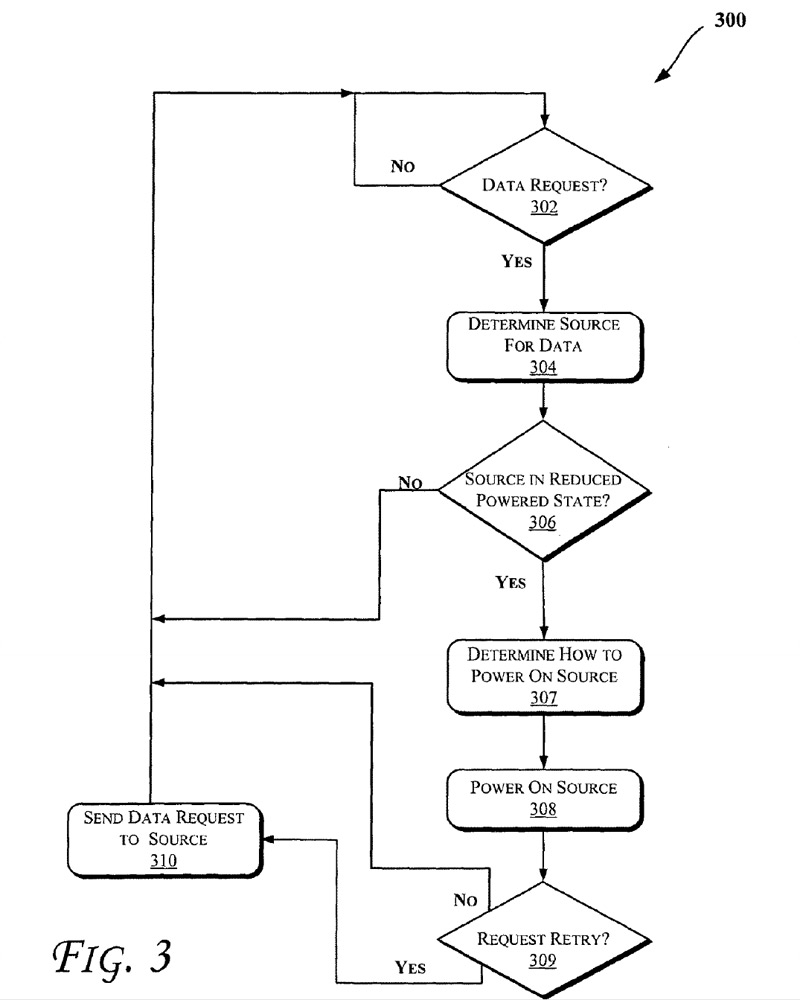Intel Receives Network-Power-On Patent
Intel has been just granted a patent which enables electronic devices to be switched on via an intermediate computing device.
The document, filed in 2007, describes a networked environment of devices and is a step beyond the WoL (Wake on LAN (Local Area Network)) feature. In an environment of at least three devices, where on device is requesting data from a second device that is turned off, there is a third device that will is capable of determining that state and switch on a computing device on demand. The benefit of such an environment may be reduced power consumption as WoL device never can be entirely turned off and will always consume power.
According to Intel, the feature of "powering on devices via intermediate computing device" not only applies to enterprise scenarios, but also home environments where "devices coupled to a network may act as distributed media storage and playback with reduced power consumption when such devices are not in use." The power-on message is supported to be transmitted via wired and wireless signals over local and wide-area networks.
While Intel remains blurry about the exact technologies and protocols being used - the patent refers to virtually any networked computing environment and their data transfer protocols - the company specifically notes that the power-on feature may be built into processors and other circuits, logic units, or devices within the system. The actual data transfer takes place "via a point-to-point (PtP) interface using PtP interface circuits, respectively." The microprocessor would include a high speed (e.g., general purpose) I/O bus channel in some embodiments of the invention to facilitate communication with various components (such as I/O device(s))," the patent states.
Get Tom's Hardware's best news and in-depth reviews, straight to your inbox.

Douglas Perry was a freelance writer for Tom's Hardware covering semiconductors, storage technology, quantum computing, and processor power delivery. He has authored several books and is currently an editor for The Oregonian/OregonLive.
-
velocityg4 This would be great. Power consumption is the reason I have yet to build a NAS for my home.Reply
Even an ARM CPU uses too much energy running 24/7 to justify setting one up just for an occasional convenience of access to all my files on all devices at all times. -
nhat11 velocityg4This would be great. Power consumption is the reason I have yet to build a NAS for my home.Even an ARM CPU uses too much energy running 24/7 to justify setting one up just for an occasional convenience of access to all my files on all devices at all times.Reply
eh how much power does your device use? My desktop can be on 24/7 and its only a few dollars a month ($2-5) -
jhansonxi Seems like a minor improvement over remote power distribution/control devices which have available for datacenters for 20 years. There may be some innovation in the specific way it handles network messages but this still seems like another frivolous patent.Reply -
drwho1 "Intel has been just granted a patent which enables electronic devices to be switched on via an intermediate computing device."Reply
really?
now?
I have been using remote controls for nearly 3 decades! -
nordlead velocityg4This would be great. Power consumption is the reason I have yet to build a NAS for my home.Even an ARM CPU uses too much energy running 24/7 to justify setting one up just for an occasional convenience of access to all my files on all devices at all times.Don't run it 24/7. My NAS consumes 30W at idle with an Atom processor, 2 HDDs, and a 8GB CF card (OS drive) and a horribly inefficient PSU. It costs $42/year to run 24/7 at $0.156/kWh (my average rate). I used to have it set to shutdown at midnight and wake up at 8AM (with WoL if I needed it outside those hours). That would cut the costs by 1/3 down to $28/year.Reply
Honestly, I was burning more energy with the Christmas lights in my house (11x100W strands) in a single hour than what the server would use in a day. -
dealcorn I like this technology if it is affordable, but do not overestimate it's dual benefits. As a replacement for WoL you may save up to the 0.5 watt or so that WoL requires, As power supplies are typically inefficient at the this output, I would read that as more like a watt or two at the plug. Second, WoL requires a hard wired connection and this does not: wireless WoL works with this approach.Reply -
JonnyDough Intel just wants a large company to screw up so they can sue for millions in "lost revenue". Ugh.Reply -
thrasher32 Hmm, sounds like a nice feature. How come Wake-On-LAN couldn't have been updated to include this functionality, I mean it seems like a no-brainer.Reply
Water under the bridge now I suppose, since Intel now holds the patent.
